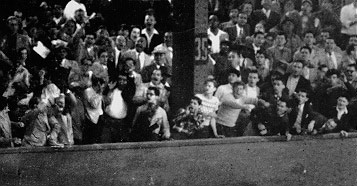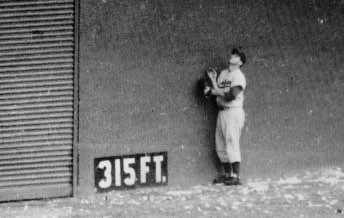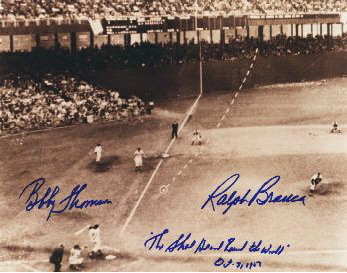
Time Period: October 3, 1951

During the 1951 season, the Brooklyn Dodgers and New York Giants ended the regular season with identical records. So a three game playoff was held. The Giants won the first game, but lost the second badly. So the pennant was up for grabs in the third playoff game. According to the New York Times, 34,320 attended the game at the Polo Grounds in Manhattan. When the Giants came up in the bottom of the ninth, they were losing 4-1.

That was the day Bobby Thomson hit the 'Shot Heard 'round the World' into the seats, over the head of left fielder Andy Pafko.

The Bruegel painting that gives the prologue its title, "The Triumph of Death" does appear in the October 1, 1951 issue of LIFE magazine, pages 66-67, in a story on the Prado museum. Here's the magazine's caption:
The final conquest of humanity by death was symbolic subject for artists during the Middle Ages, but the symbolism took on a grim reality in Pieter Bruegel's day when the armies of Spain swept over the Low Countries, ruthlessly crushing the native uprisings. In Bruegel's painting, done about 1562, the agents of death spare no one. Their bony hands touch king, cardinal, pilgrim and peasant. A fool hides under a table to escape the pale rider on the pale horse, who drives the living into a chamber of doom. Far away, ships and fortresses go up in flames, and on a stark hillside two skeletons toll the death knell of the world.
There's a sixteen-year-old in the Bronx who takes his radio up to the roof of his building so he can listen alone, a Dodger fan slouched in the gloaming, and he hears the account of the misplayed bunt and the fly ball that scores the tying run and he looks out over the rooftops, the tar beaches with their clotheslines and pigeon coops and splatted condoms, and he gets the cold creeps. The game doesn't change the way you sleep or wash your face or chew your food. It changes nothing but your life. (32)
DeLillo says he was in a dentist's chair when the home run was hit.
There's a fine essay by John W. Duvall entitled "Baseball As Aesthetic Ideology: Cold War History, Race, and DeLillo's 'Pafko at the Wall'" which appears in Modern Fiction Studies 41.2.
Duvall sees this story as DeLillo's exploration of a "series of 'us-them' binaries of the early 1950s, most significantly the United States versus the Soviet Union and whites versus African-Americans." He refers to the October 4, 1951 edition of the New York Times for verification of some of the events that are mentioned in the story.